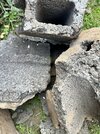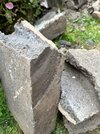Good afternoon one and all,
I am currently in the process of building a single storey extension to the rear of my early 70’s property, we are now at the stage of opening out into the extension, with RSJ fully supported in-situ.
Upon stripping the internal leaf, we have discovered hollow blocks, believed to be Clinker (after a wide internet search)?
I’ve not come across clinker before as I’ve generally been involved with new builds for the past five years, as my main form of work, so learning about new things most weeks.
There is very little information about these form of blocks in regards to strength, although I’ve read they are generally not used for load bearing and are prone for cracking etc…?
This has left me with a lot of doubt, the structural engineer I used for the calculations has advised that beam was calculated with worst strength masonry in mind which I think is 3.5N, he’s now out of office on holiday for a couple of weeks so job has come to a halt.
Padstone design - 300 x 300 x 215 cast in-situ with 3+ 220x10mm rebar placed perpendicular to the beam (beam runs inline with both bearing walls) which would distribute load between both leafs
3.6m span with 300mm bearing (4.2m total beam length) 203x133x30UB bolted together.
I know Woody and Tony both give great advise on here, and I’m sure there are other people with great knowledge too. I thought I’d ask the question on here before I pay for a second opinion with another SE.
I have included a photo of the blocks in question - which seem to be fairly strong. They are soaked through in the photos so a lot lighter in colour than this.
Many thanks,
Marcus
I am currently in the process of building a single storey extension to the rear of my early 70’s property, we are now at the stage of opening out into the extension, with RSJ fully supported in-situ.
Upon stripping the internal leaf, we have discovered hollow blocks, believed to be Clinker (after a wide internet search)?
I’ve not come across clinker before as I’ve generally been involved with new builds for the past five years, as my main form of work, so learning about new things most weeks.
There is very little information about these form of blocks in regards to strength, although I’ve read they are generally not used for load bearing and are prone for cracking etc…?
This has left me with a lot of doubt, the structural engineer I used for the calculations has advised that beam was calculated with worst strength masonry in mind which I think is 3.5N, he’s now out of office on holiday for a couple of weeks so job has come to a halt.
Padstone design - 300 x 300 x 215 cast in-situ with 3+ 220x10mm rebar placed perpendicular to the beam (beam runs inline with both bearing walls) which would distribute load between both leafs
3.6m span with 300mm bearing (4.2m total beam length) 203x133x30UB bolted together.
I know Woody and Tony both give great advise on here, and I’m sure there are other people with great knowledge too. I thought I’d ask the question on here before I pay for a second opinion with another SE.
I have included a photo of the blocks in question - which seem to be fairly strong. They are soaked through in the photos so a lot lighter in colour than this.
Many thanks,
Marcus
Attachments
Last edited:




